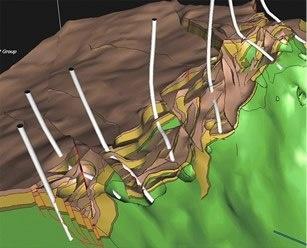Shell and IBM have formed a research collaboration that aims to extend the life of oil and natural gas fields.
Shell sees potential to reduce the time and money required to model its reservoirs. IBM's long-standing analytics and simulation experience will meet Shell's strong subsurface and reservoir expertise to create a more efficient, more accurate picture of energy recovery. The companies will explore advanced techniques for reconciling geophysical and reservoir engineering field data. As a result of applying improved algorithms, analytics and accelerated simulations, Shell can reduce the educated guesswork and extract natural resources with more certainty and efficiency, thereby optimising the recovery of oil and gas.
An example of the type of modeling image Shell uses to represent a very complex set of data. The collaboration with IBM is expected to bring even greater clarity to reservoir modeling.
"This collaboration is remarkable," said Gerald Schotman, Executive Vice President of Shell Innovation, Research & Development. "Two industrial research giants are coming together to solve a very specific, real-world problem and make the most of oil and natural gas reservoirs. This will not be done through expensive, experimental facilities, but by bringing together a powerful team and powerful computers so we can be smarter than before."
The complex process of reconciling often-differing views of oil and natural gas fields can take several months to complete and involves measurements of production volumes, flow rates and pressures. For example, geophysicists must examine time-lapse seismic data from subsurface rock formations; reservoir engineers receive well and laboratory data, and geophysicists receive information - sound waves - covering wide spaces between the wells. Shell and IBM will reformulate and automate the task of reconciling the different data and create an enhanced, yet practical, mathematical optimisation solution. This can improve the cost-effectiveness of the data inversion process and, once available, will become part of Shell's proprietary reservoir modelling tool kits for application in new oil and natural gas developments as well as existing assets.
"Working with Shell is a prime example of the importance of collaborative research in the effort to build a smarter planet," said John E. Kelly III, Senior Vice President and Director of IBM Research. "Using predictive analytics to drive new intelligence into oil and natural gas reservoir management has the potential to extend the life of existing oil and gas fields in a responsible way."
As part of this Joint Development Agreement, IBM and Shell research scientists will work in several laboratories in both the US and the Netherlands.





















